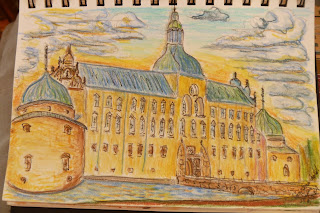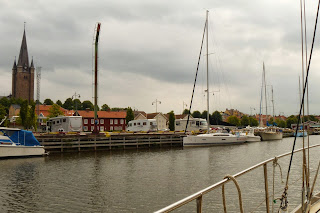Passage Report No. 95
Gota, Trollhatten Canals: Soderkoping to Gothenburg
Swedish hospitality knows no bounds. Lars:
"…I am going to Norrkoping on business, I will drive you to meet crew and return…
A nineteenth century industrial giant; Norrkoping’s textile mills and factories crowded the Motala Strom (river) till the last mill closed in 1970. Norrkoping’s challenge was to rejuvenate its heart by regenerating"…defunct mills…" into museums, shops and entertainment spaces that line wending canals and tumbling waterfalls.
With crew aboard, Sahula departs Soderkoping to engage the remaining 55 locks, numerous lakes and channels of the Gota Canal.
Skipper favoured the locks starboard side (fenders on starboard), noticing that turbulence roared in to port. Later, lock operators advised that the first boat in the lock, determined which sluice gate opened, port or starboard.
Once in the lock, crew throw a bow line to a shore operator (difficult to disembark crew at the first lock) who also attach the stern line. These lines, on board, lead to blocks, fore and aft, then tensioned at cockpit winches, by Skipper. On rising, turbulence surging past, moves bow to wall, then deflects off rear lock gate, to force off yacht stern.
Crew misses line ashore, Sahula, broaches, stern hits wall (Skipper thanks the full length gunwale timbers). Onlookers entertained. Experience gained.
Lock after lock (seven locks - Soderkoping to Norsholm), breeds efficiency. In the process, Sahula leaves red paint ensuring lock posterity.
Lock operators may operate two or three locks, riding a bicycle to each. They're young, vigorous, male, female, university students.
"...what are you studying?..."
"...engineering..."; "...science..." - many girls study these courses in Sweden.
"...passenger boat coming, pass through the bridge and wait..."
Ancient "Wilhem Tham" looms astern, Sahula is not through the bridge, retreats to find greater canal width. One hoot, pass to port; Sahula edges by.
Roan red, farm houses, huge sheds, set in wheat (or barley) fields, stretched yellow, brown, green, between tall forests.
Ducks, ducklings, geese, goslings, wildflowers and ancient trees line the canal. Manor houses; stately, storied, white, yellow; express different lives.
Sweden, into the eighteenth century, supported an royalty with attendant nobility and suppressed peasants, in a largely agricultural economy.
The canal utilises the many lakes, large and small. They are shallow - some 4 -5m. Markers set the route. Summer houses line the shore.
The canal winds, mysteriously, narrowly, through. "Blind" bends, have Sahula slowly, skirting alongside trees.
" A 100 year old canal passenger ship - ahead. Skipper, anxiously, noting the depth (canal center 3m, curving to rock sides), edges over - Australian national and "boxing kangaroo" flags fly - passengers wave, camera's click.
Alongside at Norsholm, crew shower and rest after the first day. Facilities are excellent (included in canal fee) Fuel (automatic pumps) 16.35 SEK, $2.60 ltr.
Bridges, some unmanned (video approaching vessels) - some retract, some lift (Rail bridges lift). Bells ring, red/white flashing to green. Delay is minimal.
A bridge, a lock and a train bridge, starts the day. "1832" chipped into hewn rock side, flower pots adorn the leaking, wooden lock gate. Geared handles attest to previously manual labour (now electronic hydraulics).
Light winds ahead. Tanya takes Sahula, 27 km, across Lake Roxen (5-6m depth) to Berg.
"...seven locks in succession...the "divorce maker"..." - rise Sahula (and two yachts in close company), 51m.
"...there is water on loo floor..." - not propellor shaft, not valves, not ...??? - relief! - a water hose from Tanya's water pump is fractured and repaired.
Sundowners wine, chips - well earned. A relaxing day to rest.
For 21 km, 16 locks, the Canal skirts Motala Strom (stream) and three small lakes raising the question of "why not use them?"
Tanya overheats; an unusual sound; Sahula pulls to wharf. Diagnosis: a loose generator belt preventing water cooling circulation. Un-sticking, in locks, a " blade feathering" propellor is over revving the motor. Previous rope, bound tightly, around propellor has distorted the interior delrin (nylon) bearing. Cruising has its challenges.
Crew, "...you agreed; only stops where a shower..." Skipper, incredulous, opts to move on.
Sahula waited, waited. No movement at the bridge - it was after 1800, canal closing time. Sahula returned to alongside (ploughing the silt) a stone wharf. Sunset in beautiful countryside - and no shower!
Through Beronsberg, across calm, Lake Boren (5-6 m) through Borenshult locks (6 locks, 88m rise) to Motala.
Morning on Lake Vattern to enter the marina in Vadstena Stott (castle) moat.
Built in 1545 on order of King Gustav Vasa, its defences (gun turrets, ramparts, moat) dominate menancingly. Later King Johan III converted it to a Renaissance palace. It was little used.
Vanstena is Saint Birgitta's town. Birgitta ("...weathiest woman in Sweden at the time... 13th century), married at 13, mother of eight children, Queen Blanka's lady in waiting, had divine revelations, premising God's will to create an abbey and convent from a 12th century, Vanstena palace. Bored, she travelled to Rome (accompanied by her children), staying 24 years, seeking Papal "... authority for her own monastic order. She died in Rome. Her death being "... predicted to her, five days before...". Her body was returned to Vadstena. Subsequently, canonised as Saint Birgitta (Birgittine Order; Swedens only Catholic saint) her "relics" (bones) remain, ornately boxed, in the Vanstena Birgittine Abbey.
Crew remains aboard reading - worried about flight connection, days hence.
Skipper walks (and sketches) the lakeside gardens, through cobbled streets, lined by the historic, colourful, houses of Vadstena village.
A nun in habit, grey, white, crossed headress - aged, peacefully passing, smiled.
A rose sky, sun sets over a beautiful place.
Morning across, calm, Lake Vattern (32 km) past Karlsborg fastning (fortress, never used) across Bottensjon (lake) to Forsvik. A student operator toils, turning timber handles, winding open/ closed, the canals oldest locks.
Jocularly: "...we should be paid more, they (bridge operators) just press buttons..."
Rough, hewn, jagged, sides test Sahula's fenders. Weeping walls of ancient stone, engrave "1820."
"...it was built with black gunpowder..."
"...there is a problem with the bridge, I have called services, here soon..."
Forsvik to Lake Viken - myriad of narrow channels, rock walled canals, connecting small lakes, low, wooded, islands, through a natural, water, wilderness.
Across Lake Viken (22 km) to Tatorp. Through canals and rural countryside to Toreboda, Lyrestad to Sjotorp on Lake Vattern - Sweden's largest lake. Sahula arrives with time to spare before crew departs. It is the end of the Gota Canal. Sahula will now cross, solo, Lake Vattern to the Trollhatten Canal to Gothenburg.
"...they come every month..." Sahula's "quiet wharf is the scene of a Classic Car Rally featuring large USA autos.
The morning mist compares the evening.
Daniel (Maersk Line cadet applicant) and Lassa, German sailors ("...we are more Danish (speak Danish, German, English)... live in Germany, heart in Denmark..." from Flensburg in Holsten - Schleswig - a historically, much disputed territory between Denmark and Germany) regenerated and sailed "Legat," a 26 foot sloop, to the northern end of the Gulf of Bothnia.
Sahula's Yankee (sail) furler wasn't working, "Legat's" crew assisted to repair it.
A painting in the Sjotorp restaurant museum recalls the massed labour of army "volunteers" labouring (contentedly, overseen by horse mounted officers, nobility and royalty?) to manually, build the Canal. It is the only pictorial "evidence" of their labours (apart from, poignant, worn, timber wheel barrow and rusting, tools). Photographs show only historic canal user "shipping."
Sahula transits the last lock onto Lake Vattern, turns south to historic, Mariestad. Mariestad Cathedral, 400 years old, dominates the "gamla stan" (old wooden houses, cobbled streets).
Australian yacht, "Black Butterfly" (X Yachts 50 - 22m mast, 2.7m draft), welcomes crew.
Crew disembarks to train to Gothenburg "...I enjoyed it - lot happening..."
Sahula butts a low chop, light winds, for Lacko Stott (castle).
A white "spot" looms on the horizon, closer reveals a towering, red roofed white, baroque, castle. A wharf, "beneath the walls," berths Sahula.
Built on a low hill, in the 12th century, atop an easily defended promontory, for Bishop Brynolf Algotsson - one of Sweden's wealthiest men - "...he taxed farms, but not himself..." The castle port controlled trade.
Skipper connected shore power. Electrical fumes filled the saloon. The 240 battery charger (a year "ancient") had fused.
The Bishops rein ended with the 15th century, Reformation. In 1615, by royal decree, the castle passed to Field Marshall De la Gardie and son, Magnus. He turned it "...into a magnificent baroque castle from the mid - 17th century...the most talented artists and sculptures in both Sweden and Europe spend decades working..."
He (one of the richest, most powerful men in Sweden) "...owned nine other castles and over a thousand manor houses..."
Fallen from royal grace, in 1681, Lacko Stott was resumed by the State. Having no subsequent, wealthy owners, largely, preserved the castle to the present day. Ornately painted walls and ceiling, paintings, statues adorn the interior.
Sahula departs for the Skagard (islands) to Spiken fishing village for fuel and across Lake Vattern to Vanersborg at the start of the Trollhatten Canal.
"Legat" and "Black Butterfly" both observed Sahula at anchor off Vanersborg. "Box" marina berths are avoided by Skipper as too risky, solo.
The 82 km, Trollhatten Canal "lowers" Sahula, 44 m's, in six locks. 10 km are manmade, the remainder uses the Gota Alv (river). When opened in 1800, 140 tons, was the maximum vessel tonnage. Today, modernisation allows vessels of 4000 tonnes to transit the canal.
Approaching the first bridge, Skipper notes astern a large ship. Sahula edges to the wharf and awaits with a Swedish yacht.
Passing "downhill," and a false bottom construction, avoids the turbulence of the Gota Canal locks. Crew only need to hold side lines.
Sahula moves to the first lock.
A commercial canal, the locks are not "yacht friendly" - many metres deep, lock bollards are apart, horizontally and perpendicularly, requiring the use of the ladder - there are no bollards on the lock top edge. Solo would be a challenge.
Trollhatten's large, deep, locks (one then three in succession) pass. A major engineering feat designed to overcome the Trollhatten Falls. Sahula stops to explore the original locks (1800, 1844, 1916) before cruising down the narrow, fast flowing, Gota Alv, cutting through the mountains.
The last lock at Lille Edet lowers Sahula, 6 metres. A relieved Skipper continues.
Rusting industry stands sentinel to a busier commerical riverway.
Wide, reed, yellow, marshes, home to birdlife preparing for the long winter migration south.
Church spires, red, white villages, green forest, "dot" the expansive, rural, plains.
Strategically situated, on a hill, at the junction of the Gota and Nordre Alvs, imposing, Bohus Fortress dominates the river and surrounds. Built in 1308 to defend Norway's southern border; it survived, over 350 years, 14 sieges. During one, a soldier, suicided, blowing up the Red Tower and "...several hundred Swedish...(they) flew the air like crows..." His family received farmland. Water wells built by prisoners, rapidly cooling and heating rock, took 12 years to "drill" 22 m. It ceased military use in 1786. It fell into ruin when locals used its stones. The round towers are being rebuilt.
Sahula enters Gothenburg and Lille Bommen, inner city, marina (290 DEK). Skipper is invited to a Swedish families home. A lovely evening and meal, ends Sahula's cruise across the canals and lakes of Sweden.
In Gothenburg, Sahula again meets "Juno," "Diana" and "Wilhelm Tham" - Gota Canal passenger boats.
Sahula leaves to anchor amongst the Vinga islands before crossing to Skagen on tip of Denmark's Jutland Peninsula.
Next Report: Danish artist colonies: Skagen, Kerkeminde, Faborg.
Best
David
sv Sahula
Faborg, Denmark.

































































No comments:
Post a Comment